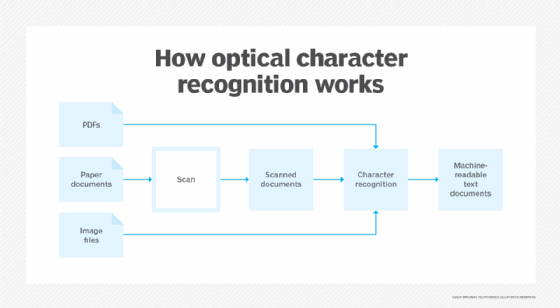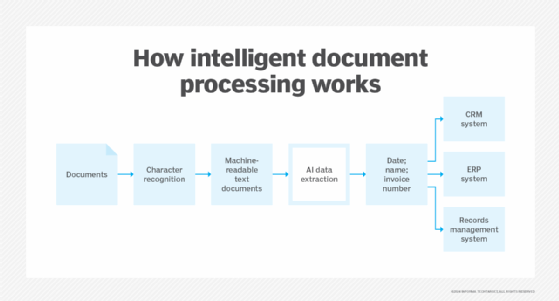
Getty Images/iStockphoto
OCR vs. IDP: What's the difference?
OCR and IDP both extract text from images, but IDP can analyze a text's meaning. Explore the key differences between these related but distinct technologies.
Optical character recognition and intelligent document processing capabilities overlap, but intelligent document processing can do more for a price.
Organizations process all kinds of documents, such as employee onboarding paperwork, handwritten forms and printed receipts, which can take up employees' time. To speed things up, OCR automates the first step in many document workflows, which is the conversion of text in PDF and scanned files into editable and searchable text documents. However, organizations that want to automate additional steps in a document workflow might require IDP.
Information professionals should know the main differences between OCR and IDP so they can choose a tool that aligns with their budget and business goals.
What is OCR?
Optical character recognition identifies words in images, PDF files and handwritten documents and then converts them into machine-readable text. Organizations commonly use this technology to speed up data entry tasks, such as digitizing books and forms.
For instance, a doctor's office might use OCR to transform scanned images of handwritten intake forms into searchable and editable text documents.

What is IDP?
Intelligent document processing combines OCR with advanced AI capabilities to help users automate complex document management workflows.
For example, a healthcare provider might use IDP to convert scanned documents into machine-readable text, categorize them based on their content, extract important data from them and route that information to a records management system.

5 differences between OCR and IDP
OCR and IDP both automate document workflows, but they differ in scope, technology, uses and pricing.
1. Scope
OCR's scope focuses on the first step in many document management workflows, which is the conversion of paper or PDF documents into digital text files. However, OCR cannot understand a document's content or automate additional steps in a workflow.
IDP, on the other hand, has a broader scope. After OCR transforms physical documents and images into searchable text, IDP applies machine learning (ML) algorithms to understand the context of the text and extract meaningful data, such as names and invoice numbers. It can then classify and validate the data and route the document for approval or to another system.
2. Technology
OCR relies on simple pattern-recognition algorithms to identify characters in scanned documents and PDF files, and matches them with various fonts and handwriting styles in a database. Some OCR tools also offer image processing capabilities to adjust the contrast and enhance images before the pattern-matching process begins. This reduces blurriness and helps the tool convert text more accurately.
While IDP includes OCR as an initial step within a larger automation process, it also offers basic pattern-matching technology. However, it includes more advanced AI technologies, such as natural language processing (NLP), ML and deep learning, to classify documents based on their content. It also uses AI analysis to identify and extract important information, such as dates or signatures, from those documents.
3. Use cases
OCR best suits organizations that want to digitize large volumes of information but don't require or lack the budget for advanced automation capabilities. For instance, universities and libraries often use OCR technology to convert books; journal articles; and historical artifacts, such as letters, into digital formats for preservation and accessibility. Similarly, accounting teams use OCR to convert paper receipts and invoices into digital formats.
Organizations that want to go beyond format conversion and automate multiple steps in a document workflow require IDP. For instance, some insurance companies use IDP to automatically extract information, like policy numbers and dates, from scanned documents to automate the claims process. Other use cases include automatic invoice and patient intake processing as well as the classification of legal documents.
4. Ease of use
OCR requires less setup than IDP because it focuses on a single task. Most OCR tools come pre-configured, requiring minimal configuration and technical expertise.
IDP, on the other hand, typically requires complex customization. For example, users might need to train the tool's ML model on company data and integrate it with other systems.
5. Cost
The cost of OCR typically ranges from free to $30 per user monthly. For instance, Microsoft OneNote and Google Drive offer free OCR capabilities, whereas tools like Adobe Acrobat Pro and Microsoft Azure AI Vision offer OCR capabilities for a fee.
Organizations can also use open-source OCR tools, such as Tesseract and DocTR, for free. Yet this approach requires some coding knowledge to implement.
IDP capabilities can cost hundreds to thousands of dollars per month and often require separate implementation and maintenance costs. Yet despite their bigger price tag, IDP tools can help organizations streamline complex workflows and significantly reduce operational costs. Examples of these tools include DataSnipper and Blue Prism Decipher.
| Difference | OCR | IDP |
| Scope | Converts scanned documents into machine-readable text. | Goes beyond OCR to automate workflows; extracts, validates and classifies data. |
| Technology | Pattern matching algorithms; image enhancement. | OCR; NLP; ML; deep learning. |
| Use cases | Converting image text into digital text files. | Automating insurance claims, payroll and employee onboarding processes. |
| Ease of use | Requires minimal technical expertise. | Requires complex setup configuration and potential ML training on company data. |
| Cost | Free to $30 per user monthly. | Hundreds to thousands of dollars per month. |
| Tools | Microsoft OneNote; Google Drive; Tesseract; Adobe Acrobat Pro. | DataSnipper; Blue Prism Decipher. |
How to choose between OCR and IDP
To choose the right tool, information management professionals should evaluate the complexity of their document processes. For instance, OCR works well for organizations that need basic text digitization capabilities.
IDP, on the other hand, makes more sense for enterprises with large volumes or complex workflows, such as those in finance, legal and healthcare industries. This technology can perform OCR tasks, but it also analyzes text information and integrates it with other systems. Additionally, IDP can digitize complex document formats and unclear handwriting styles more accurately than basic OCR tools. Therefore, organizations that process these kinds of documents might consider IDP.
Tim Murphy is associate site editor for TechTarget's Customer Experience and Content Management sites.








